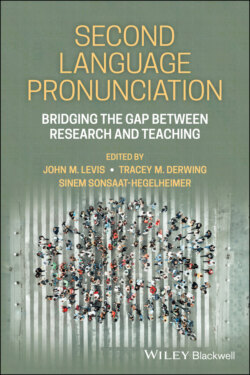Читать книгу Second Language Pronunciation - Группа авторов - Страница 27
Integrating Pronunciation with Textbook Materials
ОглавлениеEven the most creative teachers do much of their teaching with textbooks and other published and unpublished materials. The use of such materials provides a curriculum to follow, activities to choose from, and a visible focus for language learning that is shared by everyone in the class. Textbooks, however, are designed to prioritize certain skills depending on the proficiency levels of the learners, the requirements of governmental boards or pedagogical decision makers, or many other constraints. Even the best integrated-skills textbooks emphasize some skills more than others. Pronunciation skills are among the least emphasized skills in most published materials (Levis & Sonsaat, 2016), and teachers who want to integrate pronunciation into their lessons need to understand where pronunciation fits best. Fortunately, it almost always fits.
The first example (Figure 2.1), from a basic ABE class text called What’s Next (Conklin, 2011), looks at challenges faced by new immigrants or refugees in addressing problems with housing. The page excerpted here shows a fill-in-the-blank exercise with a word bank, which is meant to build sight word recognition with the housing-based vocabulary introduced in the unit. These types of fill-in-the-blank or cloze activities are common in all levels of English language classes. We suggest that teachers use these standard vocabulary building activities as opportunities to integrate lexical stress activities that require minimal preparation and are useful for learners to develop an awareness of syllables and begin to notice stress patterns. Lexical stress is both relatively easy to teach and important for intelligibility (Dalton & Seidlhofer, 1994; Levis, 2018). These types of activities can easily become routines for introducing and teaching any new vocabulary. In addition, we suggest that teachers use the commas in sentences two through five to highlight the function of thought groups and connections to punctuation. Even though punctuation is not consistently connected to pronunciation (Allen, 1971), at a basic level it is useful to call attention to the ways that written language signals pronunciation.
Figure 2.1 Possible pronunciation features in a fill-in-the-blank activity.
The second example is from Ventures, Level 4 (Bitterlin, 2018), a higher-level integrated skills textbook often used in ABE classrooms. The focus of this exercise is the difference between -ing and -ed participial adjectives (e.g., I’m bored vs. I’m boring). This is a topic with both grammatical and semantic differences that are challenging at high/intermediate proficiency levels, but the lesson also has several pronunciation features. First, it offers a chance to continue to call attention to stress in the pronunciation of multisyllabic words, showing how words with different suffixes can be pronounced with the same stress patterns. (In other cases, suffixes are associated with different stress patterns, e.g., PHOtograph, phoTOgraphy, photoGRAPHic.) In addition, the two participial suffixes in this exercise have systematically variable pronunciations. The -ing suffix variations have strong sociolinguistic differences, and -ing can be pronounced as [ɪn] (walkin’) or as [ɪŋ] (walking). Research has shown that all speakers typically use both pronunciations in some situations, but the [ɪŋ] pronunciation is judged as being more correct, more formal, more educated, and associated with higher social classes. [ɪn], on the other hand, is more common in casual speech and is more likely to be heard in the speech of younger people (e.g., Babcock, 2014).
The other pronunciation variation is found in the -ed suffix (occurring mostly on verbs), which can be pronounced with either a full syllable when the base word ends in [t] or [d] (as in depended) or as simply an extra [t] or [d] sound (as in shocked, failed) if the base word ends in any other sound. (The wrong pronunciation of these short endings can confuse listeners, since adding an extra syllable will make words like shocked sound like shock it.) It is good for learners to know that there are patterns and that the final sounds in these words are important to pronounce because of the meaning they carry.
A teacher integrating pronunciation into these textbook lessons can choose to do as little or as much as needed, but we offer the suggestions in Figure 2.2 as examples where pronunciation is clearly connected to the primary target of a textbook activity focused on other skills. The accurate use of both past and present participial adjectives is important to spoken language, and the variant pronunciations and their meanings for the participial endings are things language learners will need to be able to interpret in the spoken language of others as well as communicate their own intended meanings.
Figure 2.2 Pronunciation and the learning of participial adjectives.
